This EduRev document offers 10 Multiple Choice Questions (MCQs) from the topic Cubes & Dices (Level - 1). These questions are of Level - 1 difficulty and will assist you in the preparation of CAT & other MBA exams. You can practice/attempt these CAT Multiple Choice Questions (MCQs) and check the explanations for a better understanding of the topic.
Question for Practice Questions Level 1: Cubes & Dices
Try yourself:Directions: Read the following information and answer the given question.
A cube is coloured red on all of its faces. It is then cut into 64 smaller cubes of equal size. The smaller cubes obtained are now separated.
Q. How many smaller cubes have no coloured face?
Explanation
Number of smaller cubes with no face coloured = (n – 2)3 = (4 – 2)3 = 8
Report a problem
Question for Practice Questions Level 1: Cubes & Dices
Try yourself:Directions: Read the following information and answer the given question.
A cube is coloured red on all of its faces. It is then cut into 64 smaller cubes of equal size. The smaller cubes so obtained are now separated.
Q. How many smaller cubes have only two surfaces painted with red colour?
Explanation
Number of smaller cubes with two surfaces painted red = (n – 2) × 12 = (4 – 2) × 12 = 24
Report a problem
Question for Practice Questions Level 1: Cubes & Dices
Try yourself:Directions: One hundred and twenty five cubes of the same size are arranged in the form of a cube on a table. Then, a column of five cubes is removed from each of the four corners. All the exposed faces of the rest of the solid (except the face touching the table) are coloured red. Now, answer the question based on the above statements.
Q. How many small cubes are there in the solid after the removal of the columns?
Explanation
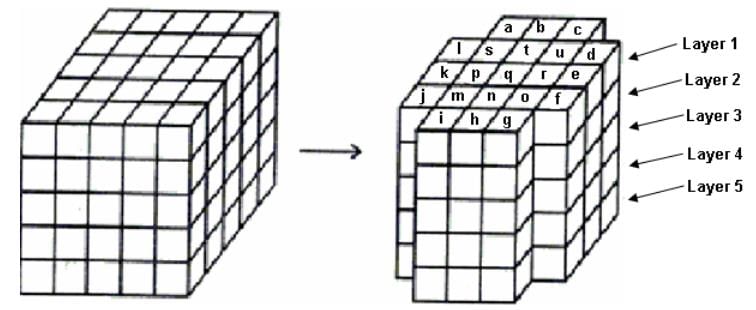
Since out of 125 total number of cubes, we removed 4 columns of 5 cubes each, the remaining number of cubes = 125 – (4 × 5) = 125 – 20 = 105
Report a problem
Question for Practice Questions Level 1: Cubes & Dices
Try yourself:Directions: Read the following information and answer the given question.
One hundred and twenty five cubes of the same size are arranged in the form of a cube on a table. Then, a column of five cubes is removed from each of the four corners. All the exposed faces of the rest of the solid (except the face touching the table) are coloured red.
Q. How many cubes have only one red face?
Explanation
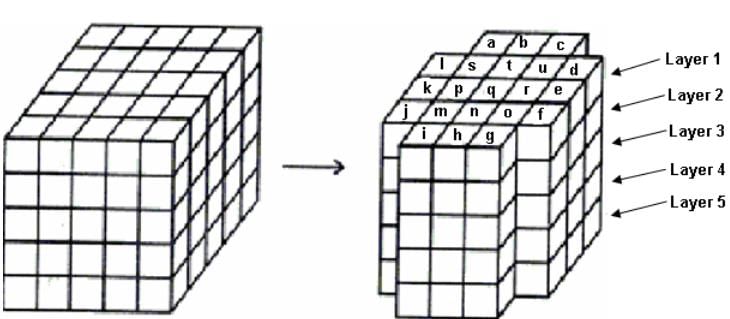
There are 9 + (4 × 4) = 25 such cubes
Report a problem
Question for Practice Questions Level 1: Cubes & Dices
Try yourself:Directions: Read the following information and answer the given question.
A cube is painted red on two adjacent surfaces, black on the surface opposite to the red surfaces and green on the remaining faces. Now, the cube is cut into 64 smaller cubes of equal size.
Q. How many smaller cubes have only one surface painted?
Explanation
Since the surfaces of the big cube are painted with some colours, so the number of smaller cubes with only one surface painted is (n – 2) × 12 = (4 – 2) × 12 = 2 × 12 = 24.
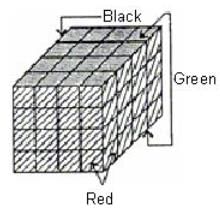
Report a problem
Question for Practice Questions Level 1: Cubes & Dices
Try yourself:Two orientations of a die are shown below. When number 2 is on the top, then which number is at the bottom?
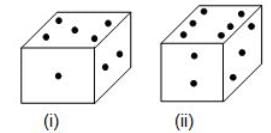
Explanation
From figures (i) and (ii), we conclude that numbers 1, 5, 6 and 3 appear adjacent to number 2.
Therefore, number 2 must appear opposite to number 4.
Thus, if number 2 is on the top, then number 4 is at the bottom.
Report a problem
Question for Practice Questions Level 1: Cubes & Dices
Try yourself:Two orientations of a dice are shown below. If the face with 1 dot is at the bottom, then how many dots will be at the top of the dice?

Explanation
From figures (i) and (ii), we conclude that 5, 4, 6 and 2 dots appear adjacent to 3 dots.
Therefore, 1 dot must appear opposite to 3 dots.
Thus, if the face with 1 dot is at the bottom, then the face with 3 dots will appear at the top.
Report a problem
Question for Practice Questions Level 1: Cubes & Dices
Try yourself:Two orientations of a block are shown below:
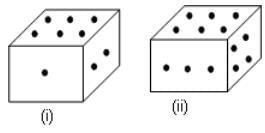
Q. When six is at the bottom, which number will be at the top?
Explanation
From figures (i) and (ii), we conclude that the numbers 1, 2, 3 and 4 appear adjacent to 6.
Thus, the number 5 will appear opposite 6.
Therefore, when 6 is at the bottom, then 5 will be at the top.
Report a problem
Question for Practice Questions Level 1: Cubes & Dices
Try yourself:In the given dice, a, b, c and d are written on the adjacent faces in a clockwise order, and e and f at the top and the bottom, respectively. When c is at the top, what will be at the bottom?

Explanation
Clearly, the six faces of the dice are labelled as shown:
Face I → a, Face II → b, Face III → c, Face IV → d, Face V → e, Face VI → f
Therefore, ‘a’ appears opposite ‘c’.
Hence, when ‘c’ is at the top, then ‘a’ will be at the bottom.
Report a problem
Question for Practice Questions Level 1: Cubes & Dices
Try yourself:Directions: Six dice are shown in the following figure, the upper faces of each dice having been erased. The number of dots on each surface of every dice has been arranged in such a way that the sum of the number of dots on the opposite faces is 7.
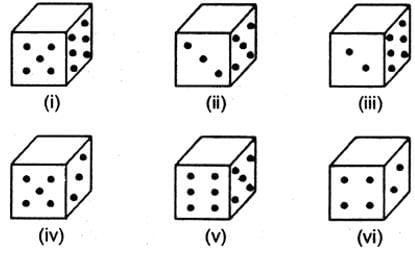
sum of the numbers on the top of first 3 dice
Explanation
According to the given figures,
Top face in (i) dice contain 3 dots;
Top face in (ii) dice contain 1 dots;
Top face in (iii) dice contain 3 dots;
Therefore,
Total dots = 3 + 1 + 3 = 7
Correct Answer: 7
Report a problem























